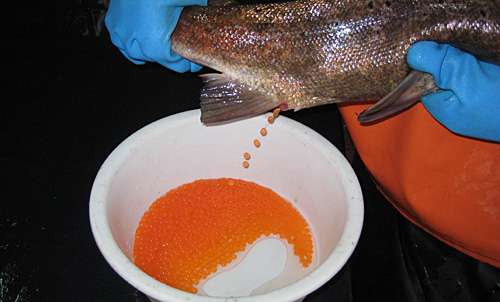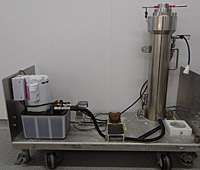"Pressured" for a solution

A simple five-minute pressure treatment makes farmed salmon sterile. Florian Sambraus may have found the solution to a highly controversial issue in Norwegian salmon production.
In the past decade over three million farmed salmon have escaped from production sites in Norwegian coastal waters, raising concerns that farmed salmon will spawn in Norway's rivers and weaken the diversity of wild salmon stocks . Increasingly, experts are pointing to triploid sterile salmon as the Norwegian aquaculture industry's best solution.
Pressure of 640 atmospheres
The process of making salmon sterile is a simple one. Half an hour after being fertilised, the salmon eggs are placed in a pressure chamber and subjected to 9 500 psi (more than 640 times the air's mean sea level pressure). A single five-minute pressure-shock treatment is enough to cause sterility by preventing the normal post-fertilisation separation of the eggs' two sets of maternal chromosomes.
"This is a simple, effective way of producing sterile farmed salmon and in no way involves genetic modification," explains Florian Sambraus, a doctoral research fellow at the Institute of Marine Research.
"Production of triploids is already common practice in fruit farming, oyster cultivation and the production of rainbow trout. This pressure-treatment method of eggs is currently the only way to ensure production of sterile salmon on an industrial scale."

Mr Sambraus believes that farming triploids can play a major role in reducing the environmental impact of salmon aquaculture.
"Triploids may also escape from their cages and head to the rivers, but they will not be able to reproduce. They cannot alter the wild stocks genetically."
Triploids need stable conditions
In his doctoral work Mr Sambraus is focused on removing the bottlenecks of industrial-scale production of triploids. Although it is simple to make eggs triploid, there are other differences not related to fertility that present production challenges.
"The metabolism of triploids differs from that of diploids (normal, fertile farmed salmon)," he says. "Triploids are more prone to spinal deformities and are more sensitive to changes in water temperature and other conditions."
In particular Mr Sambraus is studying how triploids cope with various water temperatures and whether a specialised diet may minimise deformity problems. Results of trials with 300-g post-smolts and 2.3-kg adult salmon in seawater indicate that triploid sterile salmon eat more and grow faster than diploids in water temperatures up to 9°C. At 12°C triploids and diploids demonstrate equal appetite, but triploids consume less in temperatures above this.
"The research also suggests that challenges related to deformities can likely be solved by developing specialised feed for triploids."
Is sterile salmon healthier to eat?
Mr Sambraus ventures no opinion on whether consumers will prefer salmon products from sterile or fertile fish – but he says that marketing could emphasise the health benefits of eating triploids. Because sterile salmon do not expend energy on sexual maturation, their flesh
Provided by The Research Council of Norway





















